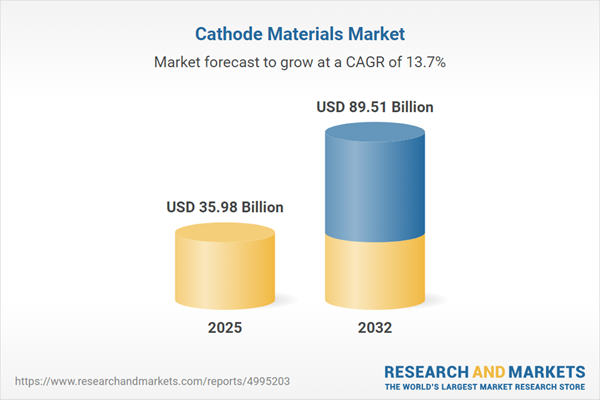Speak directly to the analyst to clarify any post sales queries you may have.
The Cathode Materials Market is advancing rapidly, shaped by the growing global demand for electric mobility, increased renewable energy integration, and ongoing innovations in battery technologies. Senior leaders seeking informed perspectives will benefit from a targeted analysis of core growth drivers, evolving segment dynamics, and strategic responses to regulatory developments.
Market Snapshot: Cathode Materials Market Growth Drivers and Opportunities
The Cathode Materials Market grew from USD 32 billion in 2024 to USD 35.98 billion in 2025. It is expected to continue growing at a CAGR of 13.71%, reaching USD 89.51 billion by 2032. Growth is propelled by advances in cathode chemistries, rising battery adoption across multiple sectors, and investments in sustainable supply chains. Sophisticated energy storage requirements for electric vehicles, grid systems, and consumer electronics position cathode technologies as core enablers of industry innovation. Steadily tightening regulatory frameworks and raw material availability further shape procurement strategies and regional expansion.
Scope & Segmentation: Comprehensive Coverage of Cathode Materials Market
- Product Types: Lithium Cobalt Oxide, Lithium Iron Phosphate, Lithium Manganese Oxide, Nickel Cobalt Aluminum.
- Synthesis Methods: Co-Precipitation, Hydrothermal, Sol-Gel, Solid State.
- Applications: Electric Vehicles, Electronics, Energy Storage Systems, Industrial Power Tools.
- End-User Industries: Automotive, Consumer Electronics, Industrial Manufacturing, Renewable Energy.
- Regional Coverage: Americas (United States, Canada, Mexico, Brazil, Argentina, Chile, Colombia, Peru), Europe, Middle East & Africa (United Kingdom, Germany, France, Russia, Italy, Spain, Netherlands, Sweden, Poland, Switzerland, United Arab Emirates, Saudi Arabia, Qatar, Turkey, Israel, South Africa, Nigeria, Egypt, Kenya), and Asia-Pacific (China, India, Japan, Australia, South Korea, Indonesia, Thailand, Malaysia, Singapore, Taiwan).
- Company Profiles: Umicore SA, BASF SE, Sumitomo Metal Mining Co., Ltd, BTR New Material Group Co., Ltd., Ningbo Shanshan Co., Ltd, LG Chem Ltd., Tianjin B&M Science and Technology Co., Ltd, Shenzhen Dynanonic Co., Ltd, JFE Chemical Corporation, EV Metals Group.
Key Takeaways for Senior Decision-Makers
- Advanced cathode materials are central to the energy density, cycle life, and safety of modern battery applications, making material selection a crucial strategic decision.
- Next-generation formulations such as high-nickel and cobalt-reduced chemistries respond to intensifying demand from both automotive manufacturers and energy storage developers, offering a balanced approach between cost-effectiveness and performance.
- Collaborative efforts among OEMs, battery producers, and mining companies are supporting sustainable supply chains, encouraging the integration of recycling initiatives and vertically integrated sourcing models.
- Circular economy principles, alongside the adoption of updated synthesis methods, enable greater control over purity, scale, and production cost, aligning with shifting regulatory and environmental expectations.
- Geographically, investments in regional manufacturing hubs and R&D centers contribute to localized innovation and reduced dependence on external raw material sources.
- Select segment growth is also linked to evolving application trends, including safety and performance demands in electric vehicles, as well as reliability considerations in grid and industrial settings.
Tariff Impact: United States 2025 Policy Effects
Recent U.S. tariff introductions on imported cathode materials have accelerated changes in global sourcing patterns and encouraged supply chain diversification strategies. Battery and automotive manufacturers are pursuing supplier expansion into cost-competitive Asian markets and scaling domestic capacities, while partnerships and joint ventures aim to reduce trade-related risks. These developments are further motivating investment in North American precursor processing and contract restructuring to uphold cost efficiency and supply security.
Methodology & Data Sources
This market assessment draws from primary interviews with senior executives, materials scientists, and supply chain experts within manufacturing, raw materials, and policy sectors. A robust review of scientific literature, patent data, industry associations, and corporate disclosures supports the findings. Proprietary analytical frameworks guide the segmentation, competitive landscape evaluation, and scenario modeling for actionable insights.
Why This Report Matters
- Enables strategic investment and partnership decisions with in-depth segment analysis and competitive positioning benchmarks.
- Equips stakeholders to respond to emerging policy and technology shifts affecting supply chains and market access.
- Supports risk mitigation through scenario-based regional outlooks and timely insights on regulatory and procurement trends.
Conclusion
Stakeholders in the cathode materials ecosystem face a dynamic future as they navigate performance requirements, regulatory changes, and supply chain priorities. This report empowers decision-makers to align strategies with market realities, fostering competitive advantage in an evolving landscape.
Additional Product Information:
- Purchase of this report includes 1 year online access with quarterly updates.
- This report can be updated on request. Please contact our Customer Experience team using the Ask a Question widget on our website.
Table of Contents
3. Executive Summary
4. Market Overview
7. Cumulative Impact of Artificial Intelligence 2025
Companies Mentioned
The companies profiled in this Cathode Materials market report include:- Umicore SA
- BASF SE
- Sumitomo Metal Mining Co., Ltd
- BTR New Material Group Co., Ltd.
- Ningbo Shanshan Co., Ltd
- LG Chem Ltd.
- Tianjin B&M Science and Technology Co., Ltd
- Shenzhen Dynanonic Co., Ltd
- JFE Chemical Corporation
- EV Metals Group
Table Information
| Report Attribute | Details |
|---|---|
| No. of Pages | 196 |
| Published | October 2025 |
| Forecast Period | 2025 - 2032 |
| Estimated Market Value ( USD | $ 35.98 Billion |
| Forecasted Market Value ( USD | $ 89.51 Billion |
| Compound Annual Growth Rate | 13.7% |
| Regions Covered | Global |
| No. of Companies Mentioned | 11 |









